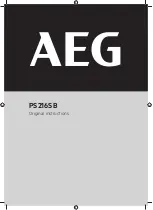
WARNING
Do not use any attachments or accessories not
recommended by the manufacturer of this product.
9.1
START THE MACHINE
Figure 5.
NOTE
The machine can not work when the lock-off button is on
the center.
1. Push the lock-off button to the left or right side to unlock
the trigger.
2. Pull the trigger to turn the machine ON.
Variable speed
The machine has a variable speed switch that delivers higher
speed with increased trigger pressure and lower speed with
decreased trigger pressure.
9.2
STOP THE MACHINE
Figure 5.
1. Release the switch trigger.
9.3
ORBITAL MOTION
Orbital motion provides faster, more effcient cutting.
Choose from four orbital adjustment position for fine to
aggressive cutting.
0
1
2
3
0
Hard materials such as metals or thin sheet
metals. This setting can be used with knife
blades, grit edge blades, rasp work, and
down cutting blades.
0
1
2
3
1
Soft materials where cleaner cutting or del-
icate scrolling work is performed.
0
1
2
3
2
Medium density materials such as harder
woods or particle board.
0
1
2
3
3
Soft materials such as wood, plastics, etc.
and when fast cutting is more important
than a clean cut.
9.4
ADJUST THE FOOTPLATE ANGLE
Figure 6.
The footplate may be tilted to allow angle cuts up to 45° in
either direction.
1. Switch the trigger to the right.
2. Adjust the angle as needed.
3. Switch the trigger to the original position.
9.5
OPERATE THE MACHINE
Figure 7.
NOTE
For best performance, always select a specified blade for
the particular application and type of material you wish to
cut.
General cutting
1. Put the front of the saw base on the workpiece
2. Align cutting edge of the blade with the line on your
workpiece
3. Start the saw and move it forward on the work surface.
Plunge cutting
1. Make the line of cut clearly on the workpiece.
2. Set the cutting blade at 0.
3. Put the front of the saw base on the workpiece
4. Use high speed to start the machine and slowly lower the
blade into the workpiece until the blade cuts through the
wood.
WARNING
To decrease the risk of injury, keep hands away from the
blade and all moving parts. Always wear safety gloves or
glasses with side shields.
10
MAINTENANCE
CAUTION
Do not let brake fluids, gasoline, petroleum-based materials
touch the plastic parts. Chemicals can cause damage to the
plastic, and make the plastic unserviceable.
CAUTION
Do not use strong solvents or detergents on the plastic
housing or components.
WARNING
Remove the battery pack from the machine before
maintenance.
10.1 CLEAN THE MACHINE
CAUTION
The machine must be dry. Humidity can cause risks of
electrical shocks.
6
English
EN



























